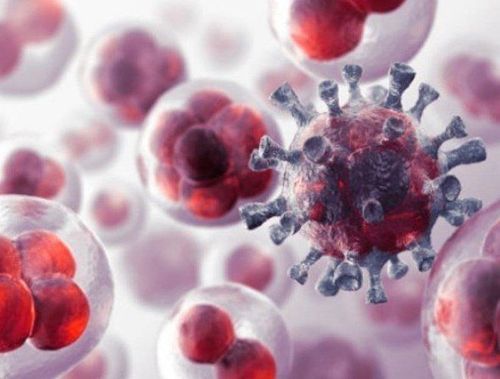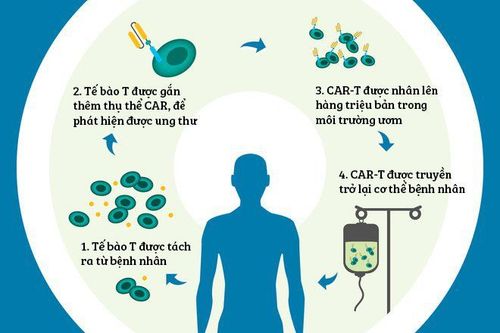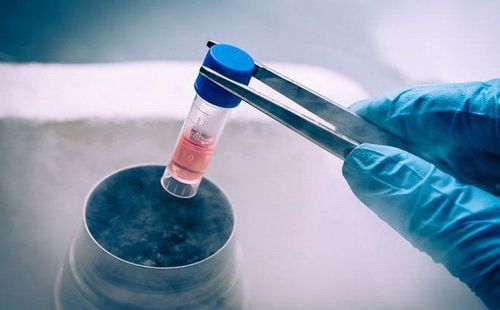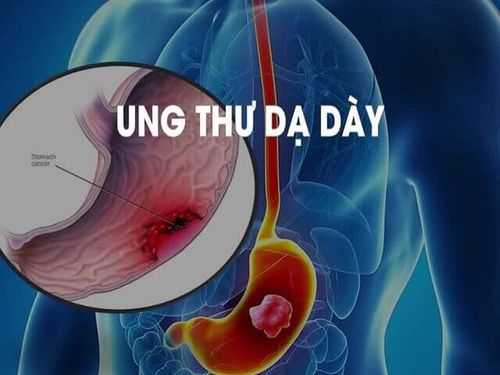This is an automatically translated article.
Immunotherapy is a type of biological therapy that boosts the immune system (made up of white blood cells and organs and tissues of the lymphatic system) to fight cancer. The method of treatment is to use substances made from living organisms to treat cancer.1. The role of immunotherapy in cancer treatment
Immunotherapy, also known as biological therapy, is a treatment that helps protect the body against cancer cells. It uses cells from the body or in a laboratory to improve or restore immune system function. Immunotherapy works to:Stop or slow the growth of cancer cells Prevent cancer cells from spreading to other organs in the body Improve the immune system to help destroy cells more effective cancer

Liệu pháp miễn dịch có tác dụng làm ngừng hoặc làm chậm sự phát triển của tế bào ung thư
2. Immunotherapy in cancer treatment
2.1 Monoclonal antibodies and tumor suppressor therapy The immune system produces antibodies to protect the body against harmful factors. An antibody is a protein that helps fight infection.Monoclonal antibody is a special therapy made in a laboratory. Therapy is performed in a variety of ways. For example, monoclonal antibodies can be used as a targeted therapy to destroy abnormal protein components in cancer cells.
Monoclonal antibodies can also be used as immunotherapy. For example, some antibodies attack specific proteins in cancer cells. This is the beginning of approaching cancer cells to help the immune system find a way to destroy cancer cells completely.
Other types of antibodies work by releasing brake-suppressing antibodies on the immune system to destroy cancer cells. The PD-1/PD-L1 and CTLA-4 pathways are important for the immune system and its ability to control cancer growth.
These pathways are often called immune checkpoints that cancer cells use to escape the immune system. The immune system blocks these pathways by producing antibodies called immune checkpoint inhibitors. Once the immune system can find and respond to cancer cells, it can stop or slow cancer growth.
Clinical trials of monoclonal antibodies are underway for several types of cancer. Many immune checkpoint inhibitors are approved for specific cancers, some used to treat tumors anywhere in the body by targeting a specific genetic change.
Side effects of monoclonal antibody treatment depend on the intent of the drug. For example, the side effects of monoclonal antibodies used for targeted therapy are different from those used for immunotherapy. The side effects of immune checkpoint inhibitors are similar to those of an allergic reaction.
2.2 Nonspecific Immunotherapy Like monoclonal antibodies, nonspecific immunotherapy also helps the immune system destroy cancer cells. Most nonspecific immunotherapies are given after or at the same time as other cancer treatments, such as chemotherapy or radiation. However, a number of nonspecific immunotherapies are offered as primary cancer treatments. Two common nonspecific immunotherapies are:
Interferon: Interferon helps the immune system fight cancer and can slow the growth of cancer cells. Side effects of interferon treatment can include flu-like symptoms, increased risk of infection, rash, and hair loss. Interleukin: Interleukin helps the immune system produce cancer-killing cells. It is used to treat kidney cancer and skin cancer, including melanoma. Common side effects include weight gain and low blood pressure. Some people may also experience flu-like symptoms. 2.3 Oncolytic virus therapy Oncolytic virus therapy uses genetically modified viruses to destroy cancer cells. First, the doctor injects the virus into the tumor. The virus then enters the cancer cells and makes copies of itself. As a result, the cells burst and die. When cells die, they release antigens. This activates the patient's immune system. The virus only targets all cancer cells in the body that have the same antigens, but does not invade healthy cells.
2.4 T-cell therapy

Liệu pháp tế bào T
Monoclonal antibodies and tumor suppressor therapy Nonspecific immunotherapy Oncolytic virus therapy T cell therapy Cancer vaccines T cells are immune cells Anti-infection. In T-cell therapy, these cells are removed from the patient's blood. Their structure is then changed in the lab to get the proteins, called receptors. The receptors allow T cells to recognize cancer cells. Once altered, the T cells are returned to the patient's body. Then, they will do the job of finding and destroying cancer cells. This type of therapy is called CAR-T cell therapy.
The use of CAR-T cell therapy is very effective in the treatment of some blood cancers. Researchers are still working to find ways to modify T cells to respond to treatment for many different types of cancer.
2.5 Cancer Vaccines Cancer vaccines are another method used to help the body fight disease. A vaccine that exposes antigens. This triggers the immune system to recognize and destroy the antigen or related foreign material. There are 2 types of cancer vaccines: preventive vaccines and therapeutic vaccines.
3. How does immunotherapy help fight cancer cells?
The reason cancer cells can grow in the body is their ability to escape detection by the immune system. Key immunotherapies help mark cancer cells, which in turn can make it easier for the immune system to find and destroy them. Other immunotherapies work to stimulate the immune system to work better against cancer cells.4. Side effects of immunotherapy
Immunotherapy can cause side effects, affecting people in different ways. The extent of side effects depends on your pre-treatment condition, the type of cancer, how advanced it is, the type of therapy you're taking, and the dose.The most common side effects are skin reactions at the injection site. These side effects include painful swelling, redness, itching, and rash. Immunotherapy can also cause severe or even fatal allergic reactions. However, these reactions are very rare.
5. How are immunotherapies introduced into the body?
The routes of entry of immunotherapy may vary depending on the therapy. Includes:Intravenous (IV) : Immunotherapy that goes directly into a vein. Oral: Immunotherapy comes in pills or capsules that the person swallows. Skin creams: Immunotherapy comes in a cream that you rub on your skin. This type of immunotherapy can be used for early-stage skin cancer. Chemotherapy into the bladder: Immunotherapy goes directly into the bladder.

Liệu pháp miễn dịch có trong viên thuốc hoặc viên nang mà người bệnh nuốt vào
6. Frequency of Immunotherapy
The frequency and duration of immunotherapy treatment depends on:The type of cancer and how advanced it is Type of immunotherapy The body's response to treatment Can be treated every day, week or month . Some immunotherapies are given in cycles. A cycle is a treatment period followed by a rest period. The rest period gives your body a chance to recover, respond to immunotherapy, and build new, healthy cells.
Vinmec Times City Hospital has successfully used Autologous Immunotherapy in the treatment of cancers. The main effect of this therapy is to help strengthen the immune system to stimulate active immune cells, increase the ability to recognize and attack cancer cells, and increase the effectiveness of treatment when combined with other methods. other treatments such as chemotherapy and radiation.
Some common cancers such as liver cancer, lung cancer, breast cancer, colorectal cancer... are all cancers that can metastasize and can be successfully treated with this therapy.
This state-of-the-art cancer therapy, when applied right in Vietnam, will bring many opportunities to prolong life for people with cancer. Many cases when the cancer turned to the terminal stage, especially metastasis, were successfully treated at Vinmec.
Radiation Oncology Center - Vinmec Times City Hospital has full equipment and a team of experienced doctors and nurses in cancer treatment (chemotherapy, radiation therapy, surgery).
Vinmec Oncology Department also continuously cooperates with prestigious hospitals of the US, France, Korea, Taiwan, Japan... to update modern treatment methods and improve professional qualifications to contribute This part increases the effectiveness of treatment while reducing the cost and time of treatment for cancer patients.













